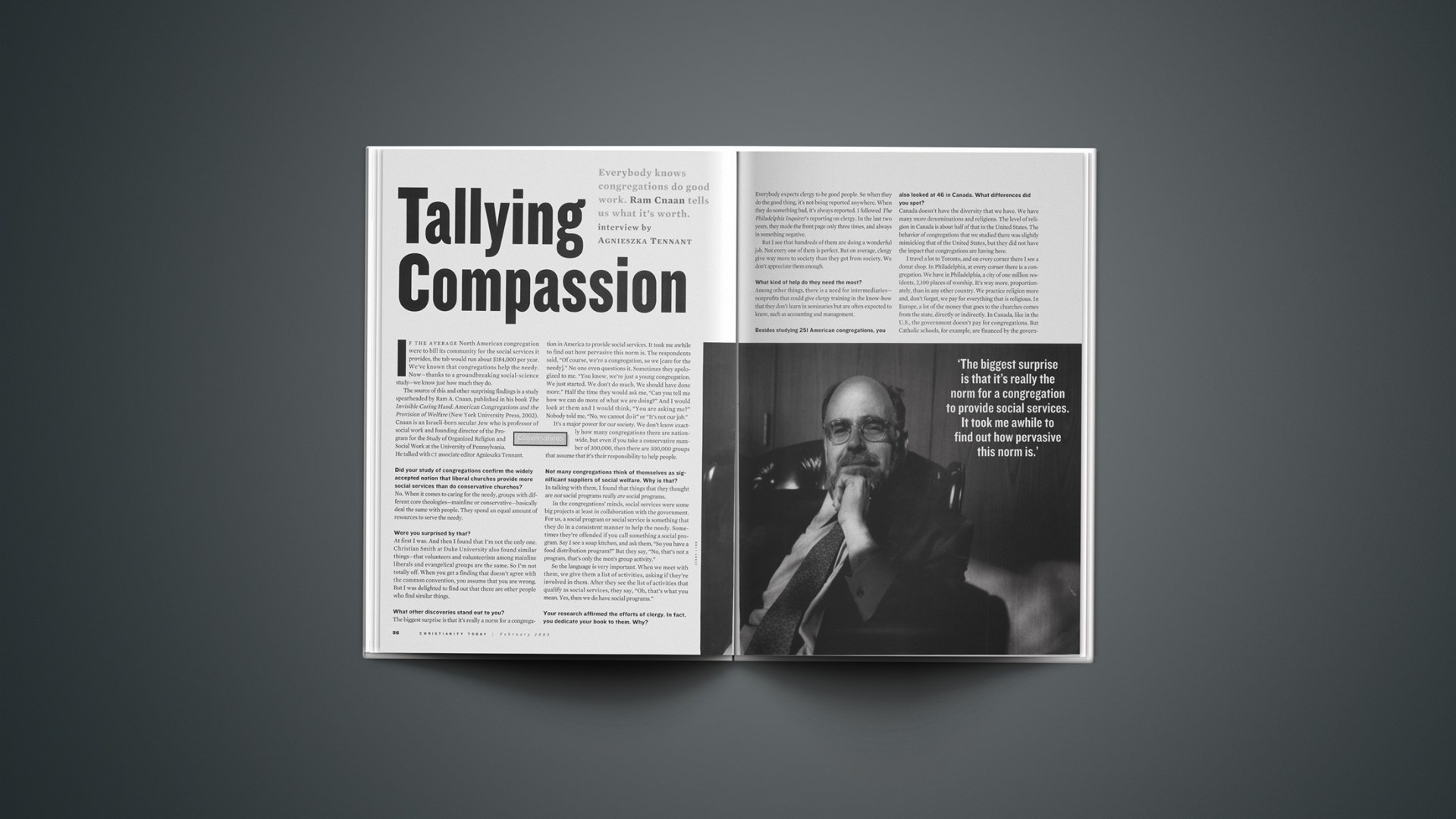If the average North American congregation were to bill its community for the social services it provides, the tab would run about $184,000 per year. We’ve known that congregations help the needy. Now—thanks to a groundbreaking social-science study—we know just how much they do.
The source of this and other surprising findings is a study spearheaded by Ram A. Cnaan, published in his book The Invisible Caring Hand: American Congregations and the Provision of Welfare (New York University Press, 2002). Cnaan is an Israeli-born secular Jew who is professor of social work and founding director of the Program for the Study of Organized Religion and Social Work at the University of Pennsylvania. He talked with ct associate editor Agnieszka Tennant.
Did your study of congregations confirm the widely accepted notion that liberal churches provide more social services than do conservative churches?
No. When it comes to caring for the needy, groups with different core theologies—mainline or conservative—basically deal the same with people. They spend an equal amount of resources to serve the needy.
Were you surprised by that?
At first I was. And then I found that I’m not the only one. Christian Smith at Duke University also found similar things—that volunteers and volunteerism among mainline liberals and evangelical groups are the same. So I’m not totally off. When you get a finding that doesn’t agree with the common convention, you assume that you are wrong. But I was delighted to find out that there are other people who find similar things.
What other discoveries stand out to you?
The biggest surprise is that it’s really a norm for a congregation in America to provide social services. It took me awhile to find out how pervasive this norm is. The respondents said, “Of course, we’re a congregation, so we [care for the needy].” No one even questions it. Sometimes they apologized to me. “You know, we’re just a young congregation. We just started. We don’t do much. We should have done more.” Half the time they would ask me, “Can you tell me how we can do more of what we are doing?” And I would look at them and I would think, “You are asking me?” Nobody told me, “No, we cannot do it” or “It’s not our job.”
It’s a major power for our society. We don’t know exactly how many congregations there are nationwide, but even if you take a conservative number of 300,000, then there are 300,000 groups that assume that it’s their responsibility to help people.
Not many congregations think of themselves as significant suppliers of social welfare. Why is that?
In talking with them, I found that things that they thought are not social programs really are social programs.
In the congregations’ minds, social services were some big projects at least in collaboration with the government. For us, a social program or social service is something that they do in a consistent manner to help the needy. Sometimes they’re offended if you call something a social program. Say I see a soup kitchen, and ask them, “So you have a food distribution program?” But they say, “No, that’s not a program, that’s only the men’s group activity.”
So the language is very important. When we meet with them, we give them a list of activities, asking if they’re involved in them. After they see the list of activities that qualify as social services, they say, “Oh, that’s what you mean. Yes, then we do have social programs.”
Your research affirmed the efforts of clergy. In fact, you dedicate your book to them. Why?
Everybody expects clergy to be good people. So when they do the good thing, it’s not being reported anywhere. When they do something bad, it’s always reported. I followed The Philadelphia Inquirer‘s reporting on clergy. In the last two years, they made the front page only three times, and always in something negative.
But I see that hundreds of them are doing a wonderful job. Not every one of them is perfect. But on average, clergy give way more to society than they get from society. We don’t appreciate them enough.
What kind of help do they need the most?
Among other things, there is a need for intermediaries—nonprofits that could give clergy training in the know-how that they don’t learn in seminaries but are often expected to know, such as accounting and management.
Besides studying 251 American congregations, you also looked at 46 in Canada. What differences did you spot?
Canada doesn’t have the diversity that we have. We have many more denominations and religions. The level of religion in Canada is about half of that in the United States. The behavior of congregations that we studied there was slightly mimicking that of the United States, but they did not have the impact that congregations are having here.
I travel a lot to Toronto, and on every corner there I see a donut shop. In Philadelphia, at every corner there is a congregation. We have in Philadelphia, a city of one million residents, 2,100 places of worship. It’s way more, proportionately, than in any other country. We practice religion more and, don’t forget, we pay for everything that is religious. In Europe, a lot of the money that goes to the churches comes from the state, directly or indirectly. In Canada, like in the U.S., the government doesn’t pay for congregations. But Catholic schools, for example, are financed by the government. So the separation of church and state as we have is uniquely American.
Is evangelism one of the major reasons that churches provide services?
Not really—not even for the more evangelical-minded congregations. I was expecting them to be providing social services in order to persuade people to change their religion and become members. I can’t tell you that this motivation doesn’t exist. They really believe that transformation is the way to health. But they know that transformation is not something that you see immediately.
When you ask them, “What is your number one hope for the people you serve?” they’ll tell you, “We want them to find Jesus in their lives.” But I asked them, “Would you stop the service if they don’t?” “Oh, no,” they say, “this is what we’d like. But it’s not a mandatory part.” An overwhelming majority of congregations do it because to provide social services is for them to actualize their faith—to be good Christian people, good Muslims, good Jews.
What makes local religious communities particularly able to provide social services?
The proximity to the needs of people. They always tell me, “We know the people who are coming by name. We know when they’re serious and what their specific needs are. If we think that’s what they need, we can give them these services. If we think they need something else, we’ll give them something else.”
Government is limited. Government programs don’t have the flexibility. A congregation can decide to give you one service and give me another service, and it’s legal, and it’s understood, and nobody can challenge it. The government has to give the same service to every citizen if the person is assumed to have the same eligibility.
It’s major power when you can change the service you give based on the specific need of the person and match the response to the real need. Plus, congregations are significantly more trusted than government.
What is the government’s strength in supplying such services?
Money—and the ability to tax or use other resources congregations don’t have. It can make general policies that affect people on a large scale. Congregations are limited in their means and their awareness or research.
How would you like to see your findings used?
I was surprised by how little people know about the wonderful work that congregations are doing. I was hoping that by making this a public story, congregations would be more acceptable to foundations and other funders. There is a reluctance by many foundations to work with congregations. I find it almost criminal.
In addition, I’d like to see religion and social services reconnected in terms of education—in seminaries and other higher institutions.
For too many years, the two were separated, and there’s a lot that the two can do together.
What’s the message you hope your study will send to congregations?
Clergy and congregants should learn to be proud of what they are providing for others. No one else does it so happily and so on their own.
Copyright © 2003 Christianity Today. Click for reprint information.
Related Elsewhere
Also appearing on our site today:
The Neighborhood’s Last, Best Hope | American congregations give more to society than they get from it.
The Invisible Caring Hand: American Congregations and the Provision of Welfare is available at Amazon.com.
Christianity Today sister publication Books & Culture ran a different edit of Agnieszka Tennant’s interview with Ram Cnaan and a review of the book.










